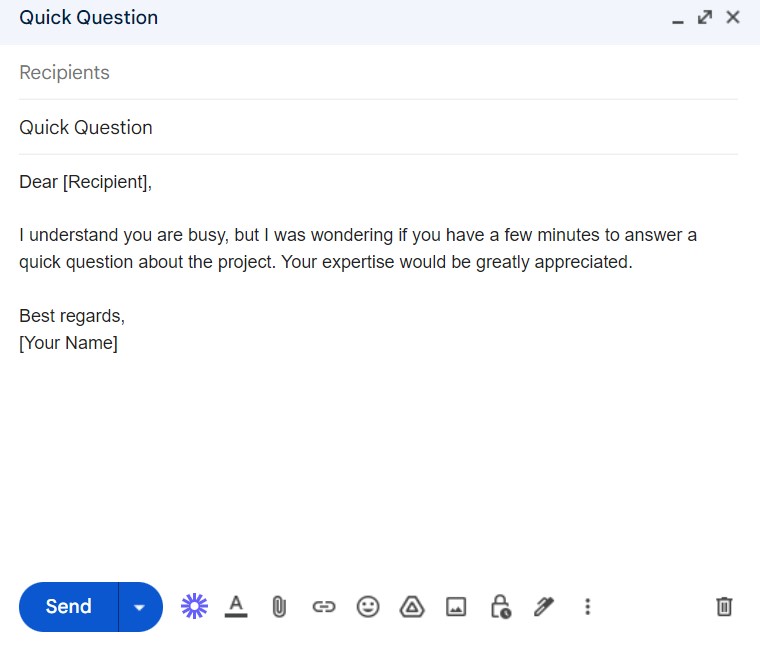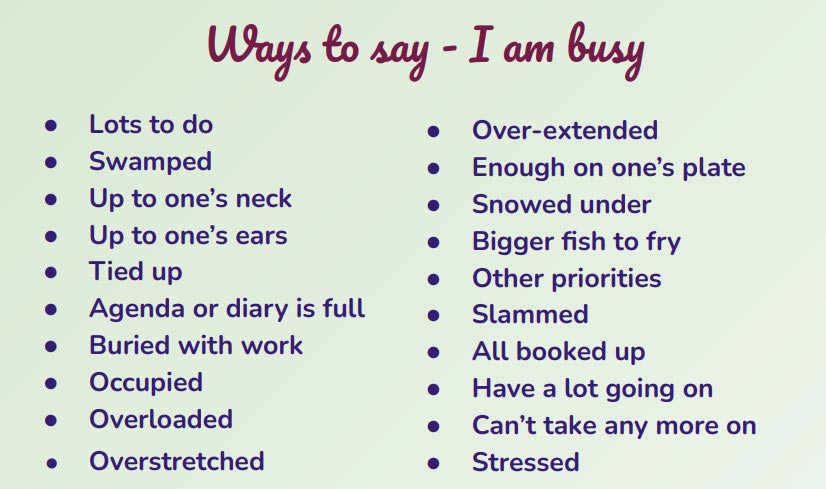How to say your busy professionally – How to say you’re busy professionally is a crucial skill for navigating the demands of modern work life. Mastering this art isn’t about deception; it’s about effectively managing expectations, protecting your time, and maintaining healthy professional relationships. This guide equips you with the strategies and techniques to politely decline requests, set boundaries, and manage your communication effectively, all while maintaining a positive and productive work environment. We’ll explore practical methods for prioritizing tasks, optimizing your email management, and even visualizing your workload for better control.
From crafting the perfect email refusal to implementing time-saving techniques like time blocking and the Pomodoro method, we’ll cover a comprehensive approach to handling a busy schedule without sacrificing professionalism or your well-being. Learn how to communicate your limitations clearly and confidently, ensuring your requests are met with understanding and respect. This isn’t about saying “no” to everything; it’s about saying “yes” strategically to what truly matters, maximizing your efficiency and impact.
Politely Declining Requests

Professionals frequently face the challenge of politely declining requests while maintaining positive working relationships. Effectively managing your time and commitments requires skillful communication, ensuring you decline requests without appearing rude or dismissive. This section explores various strategies and provides practical examples for politely declining meeting requests and other professional obligations.
Phrases for Declining Meeting Requests
Several phrases can effectively communicate your unavailability for a meeting without oversharing personal details. Choosing the right phrase depends on your relationship with the requester and the overall context. Directness is key, but always maintain a polite and professional tone.
Examples of phrases include:
- “Thank you for the meeting request. Unfortunately, my schedule is quite full at the moment, and I won’t be able to make that time work.”
- “I appreciate you reaching out. I’m currently overloaded with commitments and won’t be available for a meeting on that date.”
- “I’ve reviewed your request and, due to prior engagements, I’m unable to attend the meeting as scheduled.”
- “My schedule is quite tight this week. Would it be possible to reschedule for next week?”
Expressing Unavailability Without Detail
It’s crucial to decline requests without divulging unnecessary information about your workload or personal life. Maintaining a level of professional discretion is essential.
Consider these options:
- “Thank you for the invitation. Unfortunately, I have a prior commitment.”
- “I appreciate the invitation, but I’m not available at that time due to other obligations.”
- “Due to my current workload, I won’t be able to attend. Thank you for understanding.”
Email Template for Declining a Request
A concise and professional email template can streamline the process of declining requests while offering alternatives.
Example Email Template:
Subject: Re: Meeting Request – [Topic]
Dear [Name],
Thank you for your meeting request regarding [Topic]. Unfortunately, my schedule is fully booked during that time.
However, I would be happy to discuss this on [Alternative Date/Time] or connect you with [Colleague’s Name] who may be better suited to assist you.
Sincerely,
[Your Name]
Effectiveness of Phrases for Declining Requests
The following table compares the effectiveness of various phrases, considering formality and context. Effectiveness is rated on a scale of 1 to 5 stars (5 being the most effective).
| Phrase | Formality | Context | Effectiveness Rating |
|---|---|---|---|
| “I’m swamped, can’t make it.” | Informal | Colleague (close relationship) | ⭐⭐ |
| “Thank you for the invitation, but I’m unavailable due to prior commitments.” | Formal | Client, Supervisor | ⭐⭐⭐⭐⭐ |
| “My schedule is quite full at the moment.” | Formal | Colleague | ⭐⭐⭐⭐ |
| “Unfortunately, I’m not available then, but perhaps we could reschedule?” | Informal/Formal (adaptable) | Colleague, Client | ⭐⭐⭐⭐ |
Setting Boundaries and Expectations

Setting clear boundaries and managing expectations are crucial for maintaining productivity and preventing burnout in a professional environment. Effectively communicating your limitations and prioritizing tasks allows you to focus your energy on high-impact work, leading to increased efficiency and reduced stress. This involves proactively setting limits on your availability, communicating your workload capacity, and implementing strategies for managing interruptions.
Effective communication of workload limitations is essential for preventing overcommitment and maintaining a healthy work-life balance. Failing to set boundaries can lead to increased stress, decreased productivity, and potentially negatively impact the quality of your work. Openly and respectfully communicating your limitations prevents misunderstandings and fosters a more collaborative and supportive work environment.
Communicating Availability and Workload Limitations
Clearly communicating your availability involves proactively setting boundaries regarding your working hours, response times, and meeting schedules. This might involve specifying your typical working hours in your email signature, using scheduling tools that reflect your availability, or politely declining requests that fall outside your designated working time. For example, you might state, “My typical response time is within 24 hours during business hours (9 AM – 5 PM).” Similarly, you can politely decline meeting requests outside these hours, suggesting alternative times. The key is consistency and clear communication; once established, your boundaries should be respected.
Prioritizing Tasks and Communicating Priorities
Prioritizing tasks involves identifying the most important and urgent items on your to-do list. This might involve using methods like the Eisenhower Matrix (urgent/important), assigning priorities based on project deadlines, or ranking tasks based on their impact on overall goals. Communicating these priorities to colleagues and clients ensures everyone is on the same page and allows for realistic expectations regarding project timelines and deliverables. For example, if a client requests an urgent change that impacts a higher-priority project, you can explain the impact and propose a revised timeline. This proactive communication avoids misunderstandings and potential conflicts.
Managing Interruptions and Maintaining Focus
Managing interruptions is vital for maintaining focus and productivity. Strategies include dedicating specific times for checking emails and messages, turning off notifications during focused work periods, using noise-canceling headphones, and communicating your need for uninterrupted time to colleagues. Techniques like the Pomodoro Technique (working in focused bursts with short breaks) can also improve concentration. For instance, you could inform your colleagues, “I’ll be unavailable for meetings from 10 AM to 12 PM to focus on completing this report. Please send urgent requests via email, and I will respond as soon as possible.” This clear communication sets expectations and respects both your need for focused work and the needs of your colleagues.
Managing Email and Communication: How To Say Your Busy Professionally
Effective email management is crucial for productivity and maintaining a professional image. Constantly checking your inbox can lead to fragmented work, decreased focus, and ultimately, lower output. By implementing strategic techniques, you can regain control of your inbox and prioritize tasks effectively.
Techniques for Managing High Email Volume
Minimizing constant inbox checks requires a proactive approach. Instead of reacting to every incoming email immediately, schedule specific times throughout your day to process your emails. This could be at the start of the day, mid-morning, and once more before leaving for the day. Between these designated times, focus on your primary tasks, allowing for deeper concentration and more efficient work. Consider using email notification settings to minimize distractions. Turn off notifications entirely or set them to only alert you during your scheduled email processing times. This will significantly reduce interruptions and help maintain focus. Furthermore, utilize the “do not disturb” feature on your devices during focused work sessions.
Examples of Urgent and Important Email Subject Lines
Clear and concise subject lines are vital for effective communication and prioritization. Using s indicating urgency and importance helps recipients quickly understand the email’s nature.
- Urgent: Project X Deadline Approaching – Clearly indicates high priority and time sensitivity.
- Action Required: Client Feedback on Proposal – Signals the recipient needs to take immediate action.
- Important: Meeting Reschedule Request – Highlights the importance of the information contained within.
- [Client Name] – Request for Information (High Priority) – Prioritizes the request by explicitly mentioning high priority.
- Time-Sensitive: Travel Arrangements Confirmation Needed – Emphasizes the need for prompt action due to a deadline.
Strategies for Efficient Email Batching and Response
Batch processing emails allows for more focused and efficient responses. Instead of responding to each email individually as it arrives, group similar emails or tasks together. This approach minimizes context switching and allows for a more streamlined workflow. For example, dedicate a specific time slot to responding to client emails, another for internal communication, and another for administrative tasks. This focused approach allows for quicker processing and minimizes the overall time spent on email management. Prioritize emails based on urgency and importance; use a system like the Eisenhower Matrix (urgent/important) to categorize and prioritize your inbox.
Utilizing Email Filters and Automated Responses
Leverage email filters and automated responses to streamline your inbox and manage expectations. Filters can automatically sort incoming emails into designated folders based on sender, subject, or s. This helps organize your inbox and quickly locate specific emails. For example, you can filter all newsletters into a separate folder, or automatically archive emails from specific mailing lists. Automated responses, or “out-of-office” replies, are invaluable for managing expectations when you’re unavailable. They inform senders of your unavailability and provide an estimated timeframe for a response, preventing unnecessary back-and-forth communication. Customize your automated response to reflect your specific circumstances and anticipated return time. Consider including alternative contact information if urgent matters require immediate attention.
Using Time Management Techniques
Effective time management is crucial for professional success. It allows individuals to prioritize tasks, meet deadlines, reduce stress, and ultimately, achieve greater productivity. This section explores various time management methods, their advantages and disadvantages, common time-wasters, and a step-by-step guide for implementation.
Time Management Methods and Their Professional Applications
Several proven methods can significantly improve time management. Time blocking involves scheduling specific tasks within designated time slots in your calendar. This approach provides a clear visual representation of your day, fostering focus and preventing task-switching. The Pomodoro Technique, on the other hand, utilizes short, focused work intervals (typically 25 minutes) followed by short breaks (5 minutes). This technique leverages the principles of focused attention and regular rest to enhance concentration and prevent burnout. Another popular method is the Eisenhower Matrix (Urgent/Important Matrix), which categorizes tasks based on urgency and importance, helping prioritize crucial activities and delegate or eliminate less important ones. These techniques, when implemented correctly, can significantly increase efficiency and productivity in a professional environment.
Comparison of Time Management Techniques: Benefits and Drawbacks
Each time management technique possesses unique benefits and drawbacks. Time blocking, while providing structure and clarity, can be inflexible and challenging to adapt to unexpected interruptions. The Pomodoro Technique, although effective for focused work, may not be suitable for tasks requiring extended periods of concentration. The Eisenhower Matrix excels at prioritization but requires careful assessment of task urgency and importance, which can be subjective and time-consuming. The choice of technique depends heavily on individual work styles, task types, and personal preferences. For example, a project manager might find time blocking ideal for managing multiple projects, while a software developer might prefer the Pomodoro Technique for coding tasks.
Common Time-Wasting Activities and Minimization Strategies
Procrastination, interruptions, multitasking, and inefficient meetings are common time-wasters in professional settings. Procrastination can be mitigated through techniques like breaking down large tasks into smaller, manageable steps and setting realistic deadlines. Minimizing interruptions requires strategies such as designating specific times for email checking and turning off notifications during focused work periods. Multitasking, often perceived as efficient, actually reduces productivity due to context-switching costs; focusing on one task at a time is significantly more effective. Finally, efficient meetings require clear agendas, defined objectives, and time limits, minimizing unproductive discussions and ensuring focused outcomes.
Implementing the Pomodoro Technique: A Step-by-Step Guide
The Pomodoro Technique offers a structured approach to focused work. Here’s a step-by-step guide for implementation:
- Choose a task: Select the task you wish to work on.
- Set a timer for 25 minutes: Use a timer or app to track your work interval.
- Work on the task without interruption: Focus solely on the chosen task during this period.
- Take a 5-minute break: Once the timer rings, take a short break to rest and recharge.
- Repeat steps 1-4: Complete four Pomodoro cycles, then take a longer break (15-20 minutes).
This cyclical approach promotes sustained focus and prevents burnout, leading to increased productivity. Consistent application is key to realizing the benefits of this technique.
Visualizing a Busy Schedule

Effective visualization is crucial for managing a demanding professional workload. By creating clear visual representations of your schedule and tasks, you can gain a better understanding of your time commitments, identify potential conflicts, and prioritize effectively. This allows for proactive scheduling and minimizes the risk of overcommitment or missed deadlines.
Visualizing your schedule and tasks isn’t just about seeing what you have to do; it’s about understanding the relationships between tasks, deadlines, and available time. This understanding enables better decision-making and more efficient time management.
Sample Weekly Schedule Visualization, How to say your busy professionally
A sample weekly schedule could be represented as a grid, with each day of the week along the horizontal axis and time blocks (e.g., hourly or half-hourly) along the vertical axis. Each scheduled event or task would occupy a specific block within the grid. For example, a 1-hour meeting at 10:00 AM on Monday could be represented by a rectangle covering the 10:00 AM to 11:00 AM block on Monday’s column.
Color-coding would be used to distinguish between different types of activities. For instance: Client meetings (blue), internal projects (green), personal appointments (purple), and administrative tasks (yellow). Symbols could further enhance clarity; a small calendar icon could represent deadlines, while a phone icon could indicate calls. A key would be provided alongside the schedule to explain the color-coding and symbols used.
Prioritizing Tasks Based on Urgency and Importance
A visual aid for prioritizing tasks could utilize a simple matrix or quadrant system. The horizontal axis would represent urgency (low to high), while the vertical axis represents importance (low to high). Each task would be plotted on the matrix based on its urgency and importance.
The four quadrants created would represent different priority levels: Quadrant 1 (high urgency, high importance) would contain tasks requiring immediate attention. Quadrant 2 (low urgency, high importance) would house important tasks that should be scheduled proactively. Quadrant 3 (high urgency, low importance) would contain urgent but less critical tasks, potentially delegatable or requiring efficient time management strategies. Finally, Quadrant 4 (low urgency, low importance) would contain tasks that may be eliminated or postponed. The size of the task representation in each quadrant could visually reflect the relative time commitment required.
Benefits of Visual Scheduling and Task Management Tools
Visual tools offer several key advantages. They provide a clear overview of commitments, preventing double-booking and facilitating better time allocation. They enhance prioritization by allowing for a quick assessment of task urgency and importance. Visual representations aid in identifying potential bottlenecks or conflicts in schedules. They also improve focus and reduce stress by offering a clear picture of upcoming tasks and deadlines, enabling proactive planning and management of workload. Finally, visual tools facilitate better communication and collaboration, as schedules and priorities can be easily shared and understood by team members.






